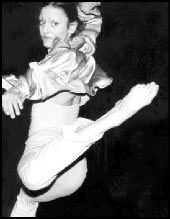BRIGHTEST PLACE
Velocity MainSpace Theater, 915 E. Pine, 2nd floor, 324-6780, $12 8 p.m. Fri.-Sat., April 26-27
SOMETIMES THE BEST theatrical effects are the simplest ones. At the beginning of brightest place, Corinna Befort’s evening of live and filmed dance, a glimmering wash of light on the sidewalls of the Velocity space turns out to be regular stage lights reflected in aluminum baking pans of water. The motion comes from a set of aquarium pumps, and as the lights fade their vibration is a pleasant hum.
“Minnow,” the dance that follows, alternates between flat-out running sequences and more lyrical sweeping and looping material. Befort sets up basic patterns through multiple repeats rather than adding variation after variation to her theme. Repetition is perhaps the most straightforward of choreographic devices, and its simplicity matches the clarity of the movement here.
Befort says that the style of the work was influenced by several marathon bicycle trips she took last summer; the running in the piece—which makes up a good half of the stage action—has the momentum and endurance of that activity. Her eight-woman cast lopes back and forth across the stage in different groupings over and over, but they aren’t exhausted or harried. Even as their breathing becomes labored, the effect isn’t harsh: The sound of their breath becomes a series of accents to David Stanford’s shimmering electronic score. “Minnow” is not a dance about endurance per se, but it mimics the intoxication of pushing the body to its limits, only to go beyond them. Even when the dance slows down, in a brief solo for Alethea Adsitt that turns and twists some of the basic material into longer phrases, it maintains the same easy skill. When the rest of the cast rejoins her, they slip back into their running patterns as if they had all the energy and time in the world.
FILM HAS THE CAPACITY to show a dance from a perspective the audience would otherwise never get—or to create a dance that cannot exist in real time and space. In “caught, wound, held,” a series of three short dance films, Befort collaborates with filmmakers Darrick Borowski and Rob Cunningham on a work that reflects several points on that continuum.
Beginning with the most realistic perspective, “caught” is practically a documentation, a real-time record of a solo performed by Befort. It’s almost possible to use the film to reconstruct the dance itself, and the camera allows us to move in closer, to repeat phrases from different perspectives, to focus on a single section of the body. An eye-level angle shows the timing of legs and arms, while a shot from overhead shows the path of her travel like a road map.
“wound,” a solo with Ellie Sandstrom, uses the camera in a more emotional fashion, revealing her essence rather than her action. When we see the tattoo on her upper back stretch as she slams into a rough alley wall, we realize that she never has this view of herself—that we know something about her that she can never know. The film jump-cuts frequently from image to image, obscuring full dance phrases but providing brief, intimate glimpses of the dancer, tiny views of her experiences. The solo itself has a desperate quality that is enhanced by this voyeuristic point of view, with her agitation reflected in the abrupt series of cuts.
“held” is the prettiest and least dancelike of the three films. Dorienne Gantar looks a bit like a Rosetti heroine on a windswept hill as she runs and leaps. Intercut with footage of a mother and child at a park, Gantar’s material threatens to become cloying, but the inclusion of some ragged vibrating and shaking helps prevent that fate. Still, it is the most predictable of the three solos, and the least revealing.
“55 Turn Handle” begins with an equally sweet image, but immediately undercuts it. A single figure in vaguely old-fashioned clothes enters the space to a Jean Redpath song, but it’s not clear that this is meant to be viewed. Her actions seem private: She strokes her face, she wipes her nose. The gentle quality of the music is reflected in her movement, but the atmosphere is far from elegiac. The trio that follows is isolating and harsh. As three women shudder through the space, their relationships are about control and manipulation, more collision than contact. The camaraderie of “Minnow” has been twisted into competition—this is the other side of the race.








